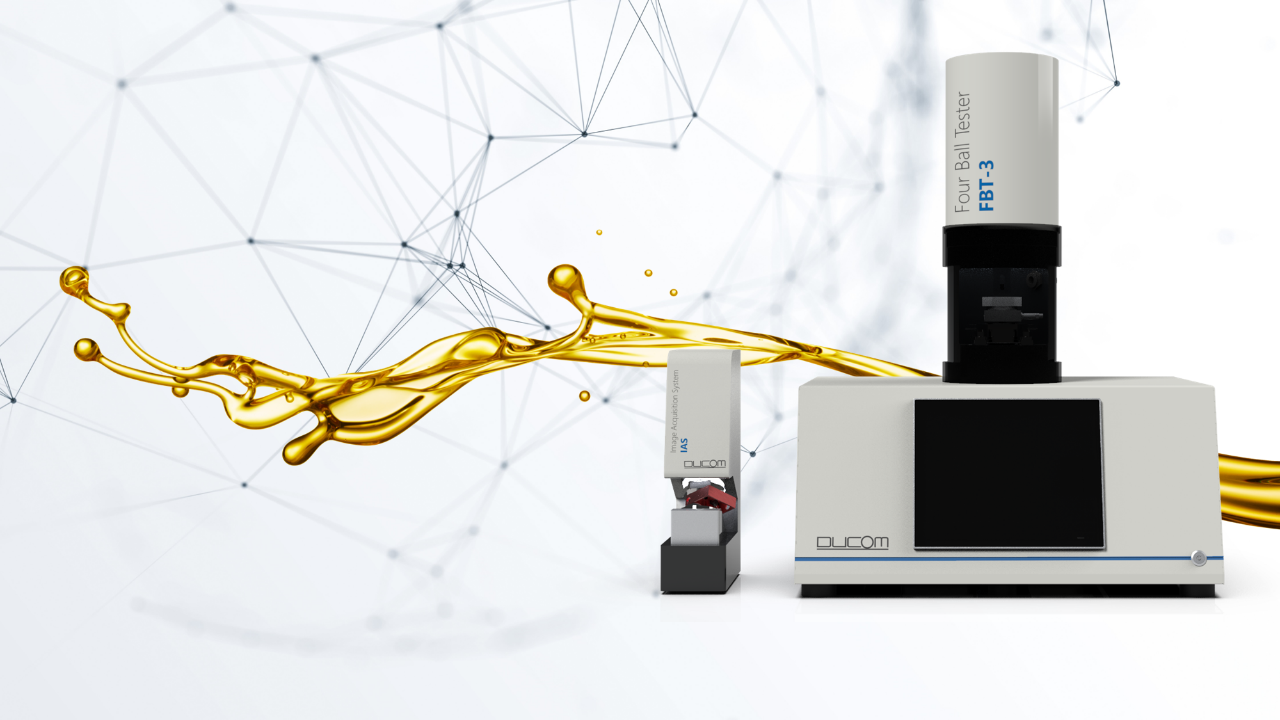
Understanding how material properties impact tribological performance is a key focus of academic research in materials science and mechanical engineering. One such critical property is thermal conductivity - a material’s ability to dissipate heat generated at the contact interface during sliding. Thermal conductivity plays a crucial role in the tribological characterization of materials and their applications. During sliding or rolling contact, frictional interactions often generate significant heat, which must be efficiently dissipated to maintain system stability and prevent thermal degradation of surfaces. Materials with high thermal conductivity can better manage this heat, reducing localized temperature rises that may lead to wear, surface damage, or failure of lubricants.

Ducom Four Ball Tester (FBT-3)
Using the Ducom Four Ball Tester FBT-3, manufactured by Paltro, Ducom’s Automation and AI division, (ASTM D4172-B setup), we investigated how materials with varying thermal conductivities influence friction, temperature rise, and wear under dry conditions. The results reveal a clear connection between thermal conductivity, friction stability, and thermal loading.
Materials & Methods
The presented tribological characterization was carried out with the aim to select the best materials coupling which could provide the highest reduction in terms of friction and wear. Tribological tests were performed using a Ducom FBT-3 according to the ASTM D4172-B standard conditions. The test parameters are reported in the next Table.
Table 1 – ASTM D4172-B test conditions.
|
Parameter |
Unit |
Value |
|
Normal load |
N |
392 ± 2 |
|
Rotational speed |
Rpm |
1200 ± 60 |
|
Temperature |
°C |
Room temperature for dry tests |
|
Test duration |
min |
60 ± 1 |
|
Fluid volume |
- |
- |
|
Test balls materials |
- |
440C steel, tungsten carbide, silicon nitride |
|
Lubricants/greases |
- |
- |
Material Thermal Conductivities
Table 2 – Thermal conductivities of the tested materials.
|
Material |
Thermal Conductivity (W/m·K) |
Notes |
|
440C steel |
~24 |
Common bearing steel |
|
Tungsten Carbide |
~85 |
High hardness, moderate conductivity |
|
Si₃N₄ (Ceramic) |
~30 |
Electrical insulator, used in dry contacts |
|
(Reference: TiN) |
~30–40 |
Mentioned for comparison |
Friction vs. Thermal Conductivity
In Figure 1 the Coefficient of Friction trend during sliding time is depicted for the tested couples in dry sliding conditions. Across all configurations, lower thermal conductivity materials (e.g., 440C steel, ~24 W/m·K) experienced higher and more unstable friction coefficients, with 440C/440C reaching ~0.39. In contrast, materials like Si₃N₄ (~30 W/m·K) and tungsten carbide (~85 W/m·K) maintained lower and more stable friction profiles—dropping close to 0.28–0.30 for Si3N4 and 0.27–0.30 for tungsten carbide. This suggests that improved heat dissipation from the contact zone reduces friction instabilities, likely by delaying transitions into adhesive or seizure-prone regimes.

Temperature Rise and Thermal Conductivity
Under dry sliding conditions, the temperature at the contact interface rose sharply for low-conductivity materials, as depicted in Figure 2. The following considerations may be noted:
This clearly indicates that higher thermal conductivity correlates with lower temperature rise, enabling more stable operation during dry friction.

Figure 2 – Temperature evolution during tribological tests.
The temperature evolution during time for lubricated tests is not reported as it is maintained constant along according to ASTM D4172-B standards.
Wear Behavior: A Compromise
The Mean Wear Scar Diameter (MWSD) was measured through the Ducom Image Acquisition System (IAS) and the different values are collected in the bar chart in Figure 3, together with the corresponding wear scars images. Interestingly, despite better thermal profiles, Si₃N₄ (ceramic) showed wear scars similar in size to 440C (~3.2 mm vs. 4.0 mm), possibly due to its higher brittleness. However, tungsten carbide, with both high hardness and high thermal conductivity, yielded the lowest wear scar diameter (~2.8 mm) under dry testing.

Figure 3 – Mean Wear Scar Diameter [mm] for 440C stationary balls against the different selected materials in dry sliding conditions.
Conclusion: Tribological Testing as a Window into Material Design
This study highlights how thermal conductivity acts as a silent driver behind tribological outcomes. The Four Ball Tester, while traditionally seen as a lubricant evaluation tool, is highly effective in material science research. By isolating thermal transport characteristics and correlating them with real-time friction and temperature data, researchers can:
For materials like Si₃N₄ and TiN, often used in advanced coatings and dry bearings, these tests offer valuable pre-application insights.
These Stories on friction
USA: +1 (847) 737-1590
India: +91 (80) 4080-5555
Netherlands: +31 (85) 065 74 10